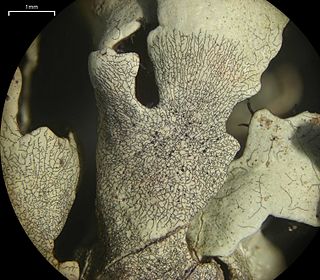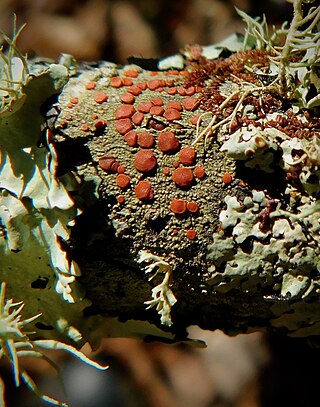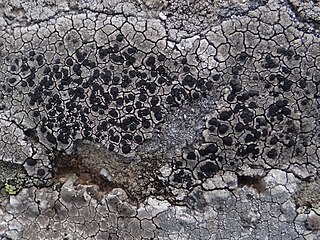
Peltigera scabrosa is a lichen which has a circumpolar distribution. Its common name is scabby pelt.

The Ostropales are an order of fungi in the class Lecanoromycetes. The order was circumscribed by Swedish botanist John Axel Nannfeldt in 1932. The order contains 4 families and 46 genera, including 6 genera of uncertain familial placement.

Muellerella is a genus of lichenicolous lichens in the family Verrucariaceae. The genus has a widespread distribution, especially in northern temperate areas, and contains species that live on other lichens, or on liverworts.

Lecanora polytropa, commonly known as the granite-speck rim lichen, is a species of saxicolous lichen in the family Parmeliaceae. A small, inconspicuous species that grows in the cracks of rock surfaces, it has a cosmopolitan distribution and has been recorded on all continents, including Antarctica.

Lichenostigma cosmopolites is a species of lichenicolous fungus belonging to the family Phaeococcomycetaceae. It was described as new to science in 1999 by lichenologists Josef Hafellner and Vicent Calatayud. The fungus grows parasitically on Xanthoparmelia lichens. In India it has been reported from the thallus of Xanthoparmelia stenophylla.

Muellerella lichenicola is a species of lichenicolous fungus in the family Verrucariaceae. It was first formally described as a new species in 1826 by Søren Christian Sommerfelt, as Sphaeria lichenicola. David Leslie Hawksworth transferred it to the genus Muellerella in 1979.

Muellerella ventosicola is a species of lichenicolous fungus in the family Verrucariaceae. It shows preference to growing on species of the genus Rhizocarpon but can also associate with other genera.

Variospora aurantia is a species of lichen belonging to the family Teloschistaceae. In Sicily, it has been reported as a host for the lichenicolous fungus species Muellerella lichenicola.
Lichenopeltella uncialicola is a species of fungus belonging to the class Dothideomycetes. The species was discovered in Iceland in 2010 where it was found growing on Cladonia uncialis. Since then, it has been found on a different host species, Cladonia rangiferina, in North-Korea, Italy Austria, and Greenland.

Muellerella pygmaea is a species of lichenicolous fungus in the family Verrucariaceae. It has a cosmopolitan distribution in Arctic-alpine areas and grows on the thallus and apothecia of a number of hosts.
Xenonectriella subimperspicua is a species of lichenicolous fungus in the family Nectriaceae. It has been recorded from South America, Europe, and New Zealand.
Zwackhiomyces polischukii is a species of lichenicolous (lichen-eating) fungus in the family Xanthopyreniaceae. It occurs in Ukraine, where it parasitises the crustose lichens Bacidia fraxinea and B. rubella.
Muellerella hospitans is a species of lichenicolous fungus in the family Verrucariaceae. It is known to infect the lichen Bacidia rubella.

Bacidia rubella is a species of corticolous (bark-dwelling), crustose lichen in the family Ramalinaceae.
Cercidospora macrospora is a species of lichenicolous fungus in the genus Cercidospora but it has not been assigned to a family. It is known from the northern hemisphere.

Xanthoparmelia stenophylla is a species of foliose lichen in the family Parmeliaceae.

Lecidea lapicida is a species of lichen in the family Lecideaceae. It has a worldwide distribution but it is rare in the tropics.
Carbonea assentiens is a species of lichen belonging to the family Lecanoraceae. It is found in Antarctica and in the islands of the subantarctic.
Capronia suijae is a species of lichenicolous fungus in the family Herpotrichiellaceae. Found in Belarus, it was formally described as a new species in 2017 by Andrei Tsurykau and Javier Etayo. The type specimen was collected from Ostrozhanka Village where it was found growing on the thallus of the bark-dwelling, crustose lichen Xanthoria parietina; Muellerella lichenicola was also simultaneously parasitizing the lichen. Capronia suijae is only known to occur at the type locality. The species epithet suijae honours Estonian lichenologist Ave Suija, "in recognition of her important contribution to the knowledge of lichenicolous fungi".










